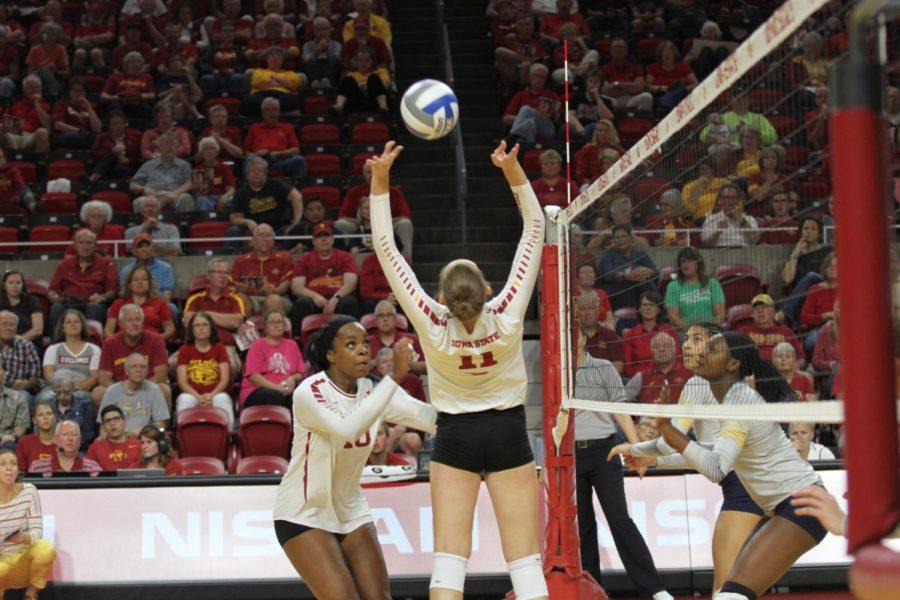Notebook: Iowa State volleyball media day focuses on setters
August 14, 2018
Iowa State volleyball relied heavily on setter Monique Harris last season with Harris playing in 99 sets for the Cyclones last season.
Harris’ eligibility expired last season, so the Cyclones will plug in a new starting setter in 2018. At Iowa State’s media day, setter was a hot topic.
Setters
Outside of Harris, Iowa State utilized Piper Mauck at setter in the 6-2 formation last season. Mauck played in 53 sets, totaling 189 assists and 79 digs.
Mauck will be back this year for her sophomore season, and joining her will be 5-foot-10 freshman setter Jenna Brandt.
While Mauck has new competition at her position, the 6-foot-1 setter welcomes the challenge.
“It’s good,” Mauck said about the competition with Brandt. “I think we’re both pretty even, and I think we both have different playing styles. I’m taller, she’s shorter, but there’s benefits to both of us.”
Mauck noted her height allowing her to do more damage blocking, but Brandt brings an element of quickness, allowing her to cover ground on the court.
Iowa State coach Christy Johnson-Lynch has picked up on the setters’ positive relationship while the two are competing, as well.
Johnson-Lynch isolates the two for 30 minutes in the morning and 30 minutes in the afternoon for setter drills.
“They seem to really have a great camaraderie [during drills],” Johnson-Lynch said. “When you’re competing for a spot, sometimes there can be some tension. They seem to get along really well.”
From a hitter’s prospective, adjusting to a new setter can be challenging. Regardless of who wins the setting job, Iowa State hitters will have to adapt without Harris.
Senior outside hitter Jess Schaben has picked up on the different traits of the Cyclone setters.
“Jenna’s really athletic and she’s quick and she can get under a lot of stuff,” Schaben said. “Whereas Piper is really tall, and she can block really well and she can dump really well. So they both have different plus sides.”
5-1 or 6-2?
With the two setters battling for the starting job, Iowa State has schematic flexibility.
“Someone needs to emerge in that position [setter], and we honestly could be a 5-1 team we could be a 6-2 team,” Johnson-Lynch said. “We’re kind of back to that question again.”
The 5-1 is a rotation with five hitters and one setter, and the 6-2 shuffles between two setters and six hitters.
The 6-2 can be more complex with more moving parts, but it’s a rotation that Johnson-Lynch and the Cyclones will explore.
“I’ve always preferred a 5-1 where we just have one setter, she’s in the whole time. It’s very easy, very clear,” Johnson-Lynch said. “The 6-2 is much more difficult.
“With the two-setter system, they’re coming in and out. You’ve got to train them both to think the same and set the same. It’s very difficult.”
From the perspective of a setter, the rotation options don’t alter them as much as the hitters.
“It’s kind of just how our hitters feel. It’s a lot harder with the 6-2 because two different setters means two different types of sets, so I don’t really have a preference necessarily.”
Cyclones are “blocked” in
Last season, Iowa State finished with 299.5 team blocks, the most since 2007. The Cyclones implemented a swinging block strategy, which paid dividends.
“I think just making it an emphasis,” said senior middle blocker Grace Lazard. “Last year, coach just told us ‘listen, these are our numbers, they suck, we need to get them better,’ and I think we visually saw that.”
The Cyclones have put more emphasis on the blocking. Lazard said that the team works on blocking and defense in every practice.
The Iowa State coaches have also focused on players’ footwork during blocking drills.
While blocking shined last season, Johnson-Lynch wouldn’t be shocked to see some regression.
“Last year was a tremendous, maybe our best-ever blocking season since I’ve been here,” Johnson-Lynch said. “The challenge will be replacing primarily Samara West and Alexis Conaway; they were two of our best blockers.
“I don’t know if our numbers will stay as high as they were last year, but I think we have a good shot at that.”
















